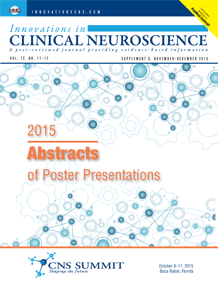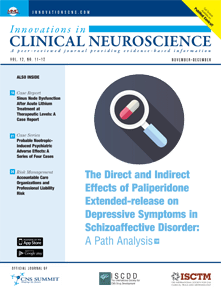Welcome to the November–December 2015 issue of Innovations in Clinical Neuroscience. First, I would like to call your attention to the accompanying supplement to this issue of the journal, a compendium of abstracts from the 2015 CNS Summit poster presentations. Each year, the CNS Summit brings together drug development leaders from pharma, research sites, and related service companies to address key issues in drug development—in a noncompetitive, interactive, collaborative environment. The poster presentations allow CNS Summit participants to share innovations in drug development research and technology as well as their clinical trial successes and lessons learned, and we are pleased to present this compendium of abstracts for the readers of Innovations.
 To access the 2015 CNS Summit abstract supplement, click here for the E-EDITION (a digital replica of the printed version) or here for the ONLINE version.
To access the 2015 CNS Summit abstract supplement, click here for the E-EDITION (a digital replica of the printed version) or here for the ONLINE version.
We open the November–December issue of the journal with a path analysis by Turkoz et al titled, “The Direct and Indirect Effects of Paliperidone Extended-release on Depressive Symptoms in Schizoaffective Disorder: A Path Analysis.” The investigators sought to evaluate the direct and indirect (changes in negative and positive symptoms and worsening of extrapyramidal symptoms) treatment effects of oral paliperidone extended-release (ER) on depressive symptoms in patients with schizoaffective disorder. A post-hoc analysis was performed on data from two six-week, randomized, placebo-controlled studies of paliperidone ER versus placebo in adult subjects with schizoaffective disorder who exhibited symptoms of depression. Results of this analysis suggest that paliperidone ER’s effect on depressive symptoms in subjects with schizoaffective disorder is mediated through indirect effects (e.g., positive and negative symptom changes) and a direct treatment effect.
Next, Nakamura et al present an unusual case of sinus node dysfunction in a patient who was administered lithium. In their article, “Sinus Node Dysfunction After Acute Lithium Treatment at Therapeutic Levels,” the authors describe a psychiatric female inpatient who developed asymptomatic severe bradycardia after being administered lithium for one week at a therapeutic level. Sinus node dysfunction caused by lithium treatment is usually observed in the setting of long-term use or toxic levels and has not been reported in short-term treatment within therapeutic levels. After withdrawal of the lithium, the patient’s bradycardia improved quickly. The authors describe other factors that may have contributed to the severity of the bradycardia. The authors encourage clinicians to regularly monitor their patients’ ECG and serum lithium levels to prevent serious or fatal complications when prescribing lithium.
Following this, Talih and Ajaltouni present their case series, “Probable Nootropic-induced Psychiatric Adverse Effects: A Series of Four Cases.” Here the authors describe four cases of probable nootropic-induced psychiatric adverse effects to illustrate the theory that the misuse of nootropics is potentially dangerous to the human brain and that certain individuals with a history of mental or substance use disorders might be particularly vulnerable to nootropics’ adverse effects. The authors also briefly describe the most common classes of nootropics, including their postulated or proven methods of actions, their desired effects, and their adverse side effects, and provide a brief discussion of the cases.
And finally, in this issue’s installment of “Risk Management,” Cash describes the potential liability risks that psychiatry practice owners should consider when forming an accountable care organization (ACO) with a local hospital and/or other physician practices. In his article, “Accountable Care Organizations and Professional Liability Risk,” Cash reviews the liability risks that likely will not change under an ACO, the new liability risks that newer integrative care models may bring, and the impact ACOs may have on medical malpractice litigation.
We hope you enjoy this issue and the supplement. As always, we welcome your feedback and submissions.
Sincerely
Amir Kalali, MD
Editor, Innovations in Clinical Neuroscience






